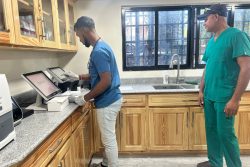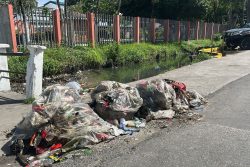Guyana’s industrial fishing sector has seen a halt in industrial licensing and a reduction in the fleet by 14% as part of continued efforts to organise the industry towards achieving sustainable fishing certification by the Marine Stewardship Council.
Chief Fisheries Officer Denzil Roberts stated that since 2011, a total of 34 vessels have been decommissioned. He noted that 20 of the trawlers that were initially decommissioned were not in proper working order and were not meeting standards. He said that “we essentially culled the ones that weren’t efficient”.
Roberts explained that after decommissioning of non-compliant vessels was done, the Fisheries Department began reducing the industrial fleet by 20 per cent. He noted that trawler owners who had 10 or more vessels would be the ones to see a reduction in their fleet. He said that since 2011, there had been some contention with trawler owners but an industrial action was taken and as a result fisher folk had to find themselves in compliance. He added that for some companies, working vessels were sent to their branches in other parts of the world.
Roberts said that the Guyana Association of Trawler Owners and Seafood Processors has met consistently with the Fisheries Department in an effort for all vested stakeholders to be included in the decision-making process. He said that at the industrial level, there is 100% compliance in licensing, which is the first step towards achieving certification.
Roberts told Stabroek News that Guyana was moving in the direction of sustainable fishing and that while aquaculture was on the rise, industrial operations had to be reworked for continued development. He said the certification from the Marine Stewardship Council would indicate that “we are practicing sustainability and it is internationally recognised”.
Roberts stated that as international markets become more interested in Guyana’s exports, Guyana had to ensure licensing was up to international standard. He recalled that European and North American importers were required to show proof of authenticity and if called upon by the relevant authorities had to show where products originated.
He noted that sales to the European Union, Canada and the United States meant that Guyana had to show that they were actively redefining the industry. He stated that the process for certification takes approximately two years and that Guyana currently is practicing TEDs (Turtle Excluder Devices), BRDs (Bycatch Reduction Devices) and VMS (Vessel Monitoring Systems) towards this end.
Roberts said that the first two were part of a conscious effort to cull the practice of overfishing. He said that while statistical data was not Guyana’s strong suit, information from fisher folk has shown a significant decline in numbers. Roberts said that many fisher folk have told the department that the amount of fish that would normally take one to two days to catch would now take three to four days.
Meanwhile, Roberts noted that the semi-industrial subsection of the industry had more work to be done. He noted that while the Venezuelan boats that were granted access to fish in Guyana’s waters were using lines in fishing red snapper, Guyanese fisher folk were using traps on the floor bed, which had ecological ramifications. He said that Guyanese did not have the skill set to use line fishing and unfortunately the traps did sometimes get lost, but continue to catch snapper.
He said that currently the Fisheries Department is discouraging trap fishing because of the ecological damage, which also includes damage to the seabed.
Roberts told Stabroek News that in the semi-industrial sector, work is being done to encourage necessary precautions in the promotion of sustainability. He said training had to become a priority and that the Fisheries Depart-ment has realised that there were deficits in the skillset that could work against the industry’s development.









